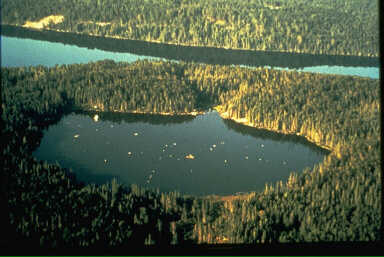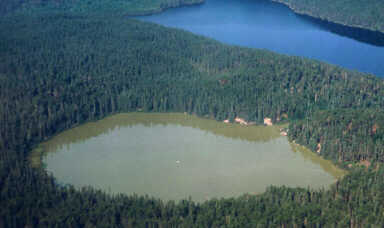 Grant Proposal
Grant Proposal
by Lindsay Husta, Audrey Smith, Christine Warzecha
 Grant Proposal
Grant Proposal
by Lindsay Husta, Audrey Smith, Christine Warzecha
|
Project Summary Project Directors: Christine Warzecha Lindsay Husta Audrey Smith Total budget: $2,500 In
this six-week project, students will learn about
the naturally occurring life cycles of lakes, investigate the nutrient
content
and species composition cycles of area waterways, and understand the
impact of
human activities on lake ecosystems. This project includes laboratory
and field
experiments, internet research, and computer modeling. The final
reports will
be presented to water quality experts from the local community. By
conducting this research, students will understand
and appreciate the vital role surface waters play in our lives and our
ecosystems. They will also learn about water systems in other states
and will
share their research results with students conducting similar research
in other
parts of the country. Finally, as
citizens, they will be able to make informed decisions about land use
as it
affects waterways.
Our
project will concentrate on the determination of trophic levels of
water
sources in Rationale
Our
precious lakes and rivers provide fresh water for
drinking and daily use, and people of all ages value waterways for
their
beauty, for recreation and for their unique aquatic ecosystems. The nutrient content and species composition
change naturally as a lake ages. However,
human activities also impact the condition of our
waterways. A recent international study by
1,360
scientists from 95 nations determined humans have “polluted or
over-exploited
two thirds of the ecological systems on which life depends, ranging
from clean
air to fresh water, in the past fifty years,” and it predicts
devastating
consequences in less than 100 years (Reuters, 5/30/05).
Human impact on natural resources will move
to the forefront of policy making within the students’ lives. Students must have a thorough understanding
of the variables which affect water to make lifestyle and political
decisions. In
this six week project, students will test local
waterways with a LCRA water expert, collect water quality data from
other
areas, and compare their research to similar projects.
Scientists will also mentor students in
design and implementation of experiments to determine potential
human-driven
effects on aquatic systems. Usually
studied late in the year, if at all, ecology receives only superficial
coverage
even though it is a macroscopic topic which may seem more interesting
and
accessible to students. Studies
show that students involved in project based
learning take control over their own learning and acquire a better
understanding of content and scientific processes (Barron, 1998). The final products, a written report and
presentation will be shared with a wider audience, students in other
classes
and representatives from LCRA respectively, so students will practice
vital
communication skills beyond demonstrating competence to the teacher
(Bruce and
Rubin, 1993, Electronic Quills). This
project will include students at the ____ level
who are taking Aquatic Science as an elective. Currently ____ students
are
enrolled in Aquatic Science, which is a one semester course currently
taught by
____ teacher. The project resources may be used each semester for
several years
to come, and we estimate that the same materials would be used to
conduct this
project for at least five years. Conducting this project over a span of
several
years will enrich the learning experience by allowing students to see
how the
same bodies of water change from year to year. Assuming that enrollment
in
Aquatic Science remains the same and this project is taught during each
semester of the next five years, approximately __________ students will
participate in this research.
A significant portion of this
project involves internet research on existing water monitoring
projects such
as those found at http://waterontheweb.org.
Internet resources could
be used to exchange water quality reports with students in other parts
of the
country who are conducting similar research.
Students will present their reports
to representatives from the Lower Colorado River Authority and other
local
groups interested in water quality; for example, neighborhood
associations in
the vicinities the tested waterways. In this way, the results of the
students’
research will inform many individuals outside the school and their
efforts will
enhance ties between the school and the community. Evaluation The
proposed projects has five main goals which we
will address will appropriate assessments. At
the end of the project, our students will have 1.
increased content
knowledge in ecology, specifically nutrient and energy cycles and
population
dynamics, 2. increased capacity for scientific thinking, 3. increased
oral and
written communication skills, 4. increased confidence in areas of
content
knowledge, scientific thinking and communication skills, and 5.
increased
interest or more positive attitudes towards science.
To test content knowledge, our
students’ scores on the ecology portion of the TAKS test will be
compared with
our previous years students’ scores on the same portion.
We may also compare the project completing
students scores with students taught by other teachers, if we find
these
students have similar test scores. Using
published tests which are known to be valid,
reliable, and fair, we will administer and pre and post assessment of
students’
scientific thinking and communication skills. We
would also have the students submit proposals to a
science fair
committee after completing the projects and compare the feedback with
that of a
class who submitted proposals but did not complete the project. We
will give the students a survey at the beginning and end of our project. The survey will assess students’ confidence
in content knowledge, scientific thinking, communication skills, as
well as
their attitudes towards science. Using
paired
comparisons, we will determine if the students experienced increased
confidence
and attitudes as a result of this project. Also,
we will test to see if the number of students who
enroll in
additional science courses or science clubs increases after our project.
|
||||||||||||||||||||||||||||||||||||||||||||||||||||||||||||||||||||||||||||||||||||||||||||||||||||||||||||||||||||||||||||||||||||||||||||||||||||||||||||||||||||||||||||||||||||||||||